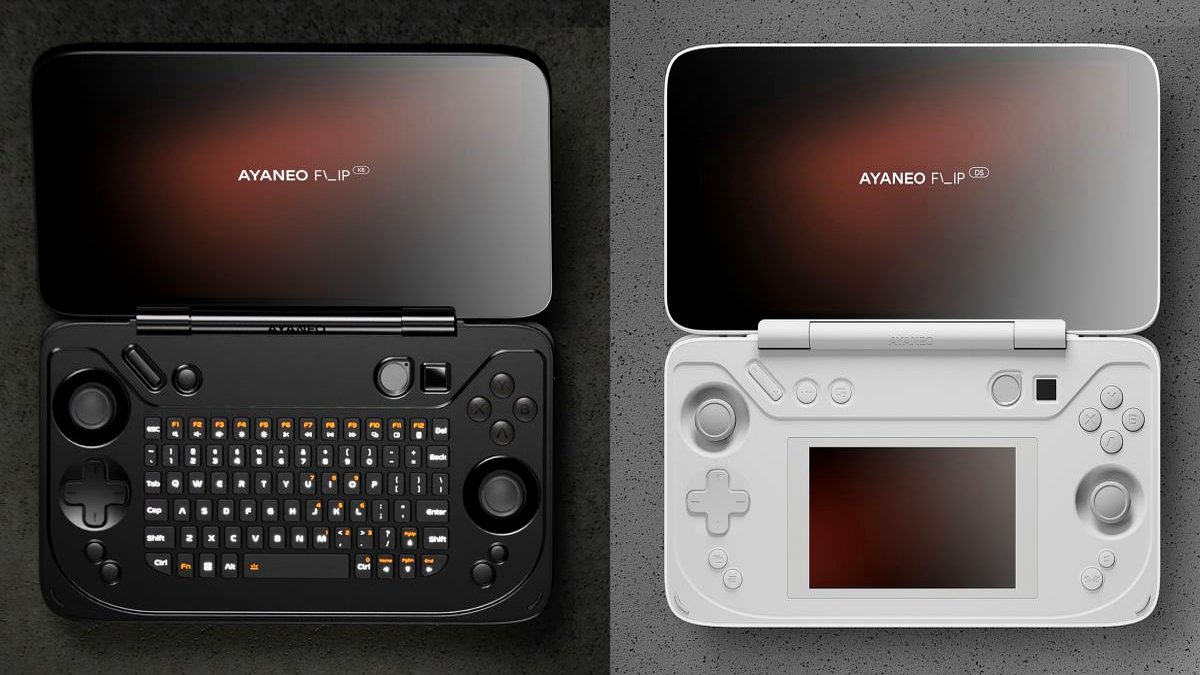AYANEO has officially confirmed a July 7-13 launch window for its highly anticipated Flip 1S gaming handhelds, marking the company's return to the dual-screen clamshell form factor. The announcement reveals specific availability dates for both the dual-screen DS variant and the built-in keyboard KB model, with the devices set to debut through Indiegogo crowdfunding before broader market release.
Redesigned Architecture Drives Performance Focus
The Flip 1S represents a comprehensive redesign rather than incremental hardware updates, with AYANEO implementing architectural improvements across both display technology and internal components. Both variants feature 7-inch OLED displays operating at 144Hz refresh rates, delivering up to 800 nits peak brightness for enhanced visibility in diverse lighting conditions.
The dual-screen DS variant incorporates a secondary 3.5-inch IPS display with 1,620 x 1,080 resolution and 3:2 aspect ratio, providing dedicated space for system controls, game information, or productivity applications. This secondary display maintains separate functionality from the primary gaming screen, enabling multitasking capabilities unique to the clamshell handheld format.
Both models integrate TMR (Tunneling Magnetoresistance) joysticks and CNC-machined top covers, representing material quality improvements over previous AYANEO generations. The precision manufacturing approach aims to address durability concerns that have historically affected handheld gaming devices operating in portable environments.
Competitive Positioning in Expanding Clamshell Market
The July launch timing positions AYANEO directly against established clamshell competitors including the GPD Win Mini 2025 and OneXPlayer G1, both of which have gained market traction through innovative form factor implementations. The Flip 1S launch represents AYANEO's strategic response to growing consumer interest in alternative handheld gaming formats beyond traditional single-screen designs.
The clamshell segment addresses specific use cases where traditional handheld designs prove inadequate, particularly in productivity applications and extended gaming sessions requiring additional interface options. The dual-screen configuration enables simultaneous game display and control interface presentation, reducing on-screen overlay requirements that compromise gaming visuals.
The keyboard variant specifically targets productivity-focused users seeking laptop-like functionality within handheld gaming hardware. This market positioning differentiates AYANEO from competitors focusing exclusively on gaming-optimized designs, potentially capturing market segments requiring hybrid device capabilities.
Strategic Launch Implementation Through Crowdfunding
AYANEO's Indiegogo-first launch strategy reflects established patterns within the boutique handheld gaming market, where crowdfunding platforms provide early market validation and community engagement opportunities. The preview campaign page demonstrates company confidence in consumer demand while enabling pre-launch feedback integration.
The crowdfunding approach also enables flexible pricing strategies and early supporter incentives that traditional retail channels cannot accommodate. Previous AYANEO campaigns have successfully leveraged early bird pricing and exclusive configurations to build launch momentum before mainstream availability.
The July launch window positions the device during peak summer gaming seasons when handheld device sales typically increase, particularly in markets where portable gaming gains prominence during travel and vacation periods. This timing avoids competitive pressure from major platform releases while capturing seasonal demand.
Technical Implementation and Design Philosophy
The Flip 1S architecture demonstrates AYANEO's commitment to addressing previous generation limitations through comprehensive hardware redesigns. The integration of high-refresh OLED technology represents significant display quality improvements, particularly for fast-paced gaming content where motion clarity proves critical.
TMR joystick implementation addresses analog input precision concerns that have affected competitive handheld devices, providing more accurate control input for gaming applications requiring precise directional control. This technology represents advancement over traditional potentiometer-based analog controls commonly used in budget handheld designs.
CNC machining for top cover construction indicates premium build quality positioning, potentially justifying higher pricing compared to injection-molded alternatives. The manufacturing approach suggests AYANEO's targeting of enthusiast markets willing to pay premiums for superior construction quality and design refinement.
Market Implications for Handheld Gaming Segment
The Flip 1S launch contributes to growing diversity within handheld gaming hardware, challenging traditional assumptions about optimal portable gaming form factors. Consumer acceptance of dual-screen and clamshell designs will likely influence future product development across the broader handheld gaming industry.
The availability of multiple form factor options enables consumers to select devices matching specific use case requirements rather than accepting compromises inherent in single-design approaches. This market evolution parallels smartphone industry developments where diverse form factors serve different consumer preferences and applications.
AYANEO's continued investment in alternative handheld designs validates the viability of niche market segments within the broader portable gaming ecosystem. Successful execution could encourage additional manufacturers to explore innovative form factors beyond established handheld gaming templates.
Key Specifications:
- Display: 7-inch OLED, 144Hz, 800 nits peak brightness
- Secondary Display (DS variant): 3.5-inch IPS, 1,620 x 1,080, 3:2 aspect ratio
- Controls: TMR joysticks
- Construction: CNC-machined top cover
- Launch Window: July 7-13, 2025
- Availability: Indiegogo crowdfunding platform initially
- Variants: Dual-screen (DS) and keyboard (KB) configurations
Sources
Note: All sources have been verified for accuracy and editorial standards compliance.
